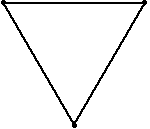
Remember
this one?
In this problem, the three bugs start at the corners of an equilateral triangle (with side length=10 inches).
Again, the bugs travel directly towards their neighbor (counter-clockwise). And, again, each bug homes in on its target, regardless of its target's motion. So, their paths will be curves spiraling toward the center of the triangle, where they will meet.
What distance will the bugs have covered by then, and how did you determine it?
[note.... NOT TRYING TO CHEAT....this is now edited after Richard, SilverKnight and Charlie pointed out that the original answer was wrong...]
[IT IS NOT CHEATING TO UPDATE SOLUTIONS AS LONG AS YOU STATE UP FRONT THAT YOU DID SO]
[Updated now for the THIRD -- and LAST - time, after Charlie had to point out to me that when you subtract a negative number. you are really adding a positive number...SHEESH !!]
Answer: 6.6666666667 inches per bug, 20 inches combined for the three bugs.
Explanation:
When I saw that this puzzle involved spirals, and that the concept of a spiral was a real challenge even for the ancient Greek Archimedes, who remains to this day the most gifted of mathematicians (he was doing the equivalent of both differential and integral calculus when Newton's and Leibnitz's ancestors were hunting the wild boar in the forests of Europe), I decided I would need a little help solving it, so I quickly attended Harvard. (physics.harvard.edu)
If N bugs begin at the vertices of a regular N-polygon of length L, then at any point in time, they will be at the vertices of a regular N-polygon. This is the only formation that respects the symmetry of the N bugs. This polygon will diminish and rotate until it shrinks to a point in the center of the original polygon.
The relative speed of two adjacent bugs is constant. That is because the relative angle of the two bug's motion is always the same. If V is the absolute speed of the bugs, then the rate at which the separation between two adjacent bugs diminishes is:
Vr = V*(1-cos[2*pi/N radians])
Then if N bugs start at a distance L apart, and if they always move at relative speed Vr, then they will meet in time T = L/(V*(1-cos[2*pi/N radians]))
V is constant.
Then each bug will have gone:
V*T = L/(1-cos[2*pi/N radians])
For L=10, N=3
10/(1-cos[2*pi/N radians])
= 10/(1-cos[120 degrees])
= 10/1.5
= 6.6666666667
Edited on January 23, 2004, 11:05 pm
|
|
Posted by Penny
on 2004-01-22 14:45:02 |
 Remember this one?
Remember this one?


